An Experimental Study on Color Shift of Injection-Molded Mobile LGP Depending on Surface Micropattern
Abstract
:1. Introduction
2. Theory
2.1. Color Chromaticity
2.2. Two Types of Total Transmittance Measurement
3. Experiments
3.1. Material and Molding Equipment
3.2. Experimental Conditions
3.3. Measurement of Optical Properties
4. Results
4.1. Measurement of Color Coordinates from Total Transmittance
4.2. Measurement of Color Coordinates from Direct Transmittance
4.3. Color Coordinate Data of Case No. 5
5. Conclusions
Author Contributions
Funding
Conflicts of Interest
References
- Ju, Y.H.; Park, J.H.; Lee, J.H.; Lee, J.Y.; Nahm, K.B.; Ko, J.H.; Kim, J.H. Study on the Simulation Model for the Optimization of Optical Structures of Edge-lit Backlight for LCD Applications. J. Opt. Soc. Korea 2008, 12, 25–30. [Google Scholar]
- Joo, B.Y.; Ko, J.H. Simulation Study of Injection-Molded Light Guide Plates for Improving Luminance Uniformity Based on the Measured Replication Quality of Micro-Patterns for LED TV Backlight. J. Opt. Soc. Korea 2015, 19, 159–164. [Google Scholar]
- Yokoi, H.; Han, X.; Takahashi, T.; Kim, W.K. Effects of Molding Conditions on Transcription Molding of Microscale Prism Patterned Using Ultra-High-Speed Injection Molding. Polym. Eng. Sci. 2006, 46, 1140–1146. [Google Scholar]
- Hong, S.K.; Min, I.K.; Yoon, K.H.; Kang, J.J. Effects of adding injection–compression to rapid heat cycle molding on the structure of a light guide plate. J. Micromech. Microeng. 2013, 24, 015009. [Google Scholar]
- Lee, K.H.; Jang, K.K.; Kim, P.J.; Yoo, K.T. Backlight Unit Including Light Emitting Diodes and Liquid Crystal Display Device Including the Same. U.S. Patent 8,339,541 B2, 4 December 2012. [Google Scholar]
- Lee, J.H.; Kang, J.J.; Yoon, K.H.; Kim, J.S. A Study on the Change of Optical and Mechanical Properties by Reprocessing for High Melt-Indexed Polycarbonate Used in Injection Molded Optical Parts. Trans. Mater. Process. 2018, 27, 211–221. [Google Scholar]
- Song, M.C.; Liu, Z.; Wang, M.J.; Yu, T.M.; Zhao, D.Y. Research on effects of injection process parameters on the molding process for ultra-thin wall plastic parts. J. Mater. Process. Technol. 2007, 187–188, 668–671. [Google Scholar]
- Kwon, J.H.; Jun, H.J.; Gwag, J.S.; Lee, H.S. Effect of Wavelength-dependent Scattering on the Color Chromaticity of the LCD Backlight. J. Opt. Soc. Korea 2013, 17, 275–278. [Google Scholar]
- Hong, C.S.; Kim, C.K.; Lee, B.W.; Lee, M.R. Optical Characteristics of LGP with Nanometer-patterned Grating. J. Inst. Control Robot. Syst. 2008, 14, 353–360. [Google Scholar]
- Jung, T.S.; Jang, J.H.; Kim, J.S. A Study on the Filling Pattern Imbalance in High Speed Injection Molding Process for Thin Light Guide Plate. Polymers 2017, 41, 30. [Google Scholar]
- Yin, S.F.; Ruan, F.; Wang, J.Y. Theory Study and Numerical Analysis of Ultra-thin Wall Injection Molding. Adv. Mater. Res. 2012, 538–541, 1145–1153. [Google Scholar]
- Min, I.K.; Yoon, K.H. Dynamic measurement of stress optical behavior of three amorphous polymers. Korea Aust. Rheol. J. 2012, 24, 73–79. [Google Scholar]
- Min, I.K.; Lee, S.J.; Lee, S.H.; Kim, J.S.; Yoon, K.H. An experimental study of yellow shift in injection-molded light guide plate. Korea Aust. Rheol. J. 2016, 28, 187–196. [Google Scholar]
- Munsell, A.H. Color notation. In A Color Notation; Geo. H. Ellis Co.: Boston, MA, USA, 1905; pp. 55–61. [Google Scholar]
- Wright, W.D. A re-determination of the trichromatic coefficients of the spectral colours. Trans. Opt. Soc. 1929, 30, 141–164. [Google Scholar]
- Guild, J. The colorimetric properties of the spectrum. Philos. Trans. R. Soc. Lond. Ser. A Contain. Pap. A Math. Or Phys. Character 1931, 230, 149–187. [Google Scholar]
- Smith, T.; Guild, J. The CIE colorimetric standards and their use. Trans. Opt. Soc. 1931, 33, 73–134. [Google Scholar]
- Berns, R.S. Visual Color Specification. In Billmeyer and Saltzman’s Principles of Color Technology, 3rd ed.; Jo, M.S., Kim, C.S., Kang, B.H., Kim, D.H., Eds.; Sigmapress: Seoul, Korea, 2003; pp. 85–119. [Google Scholar]
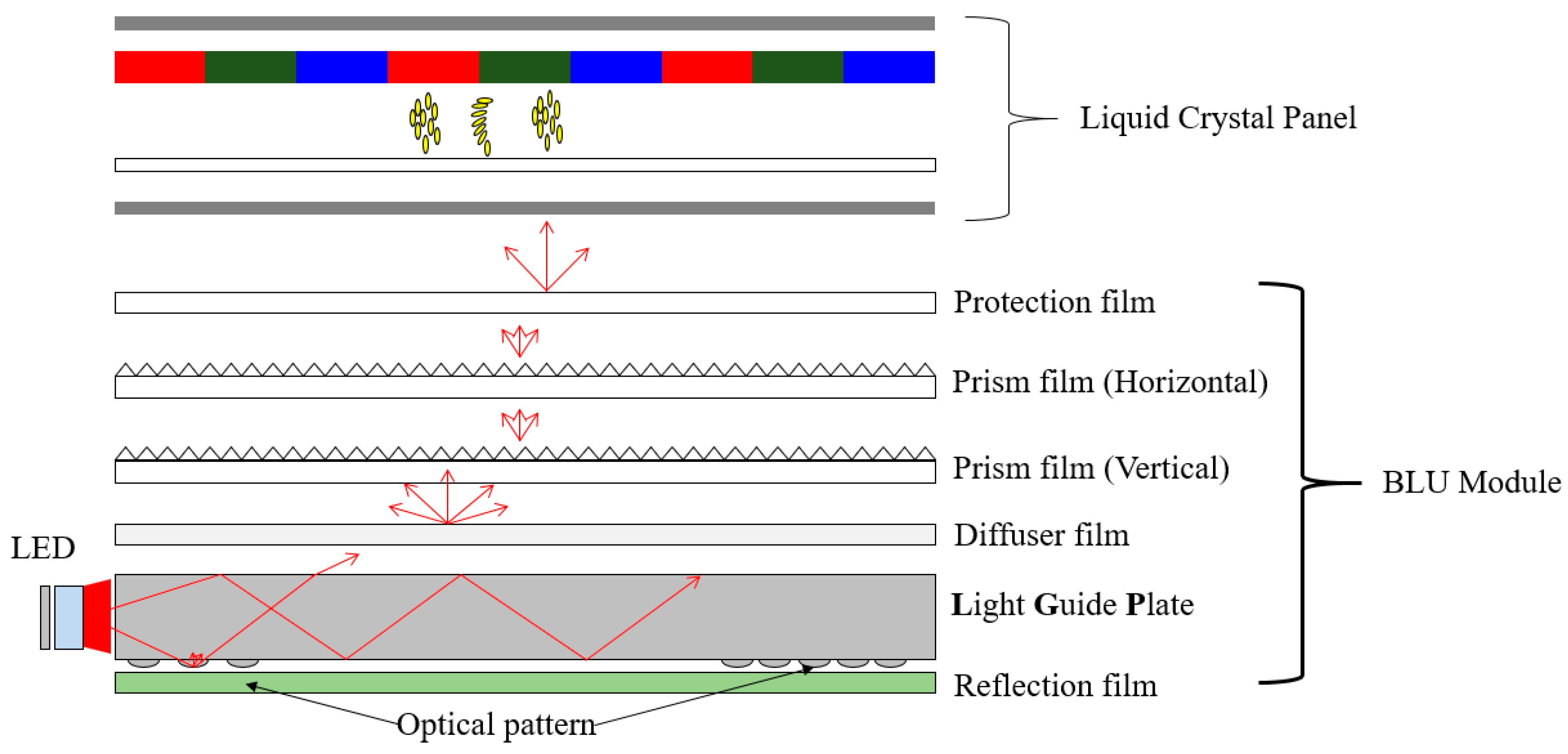

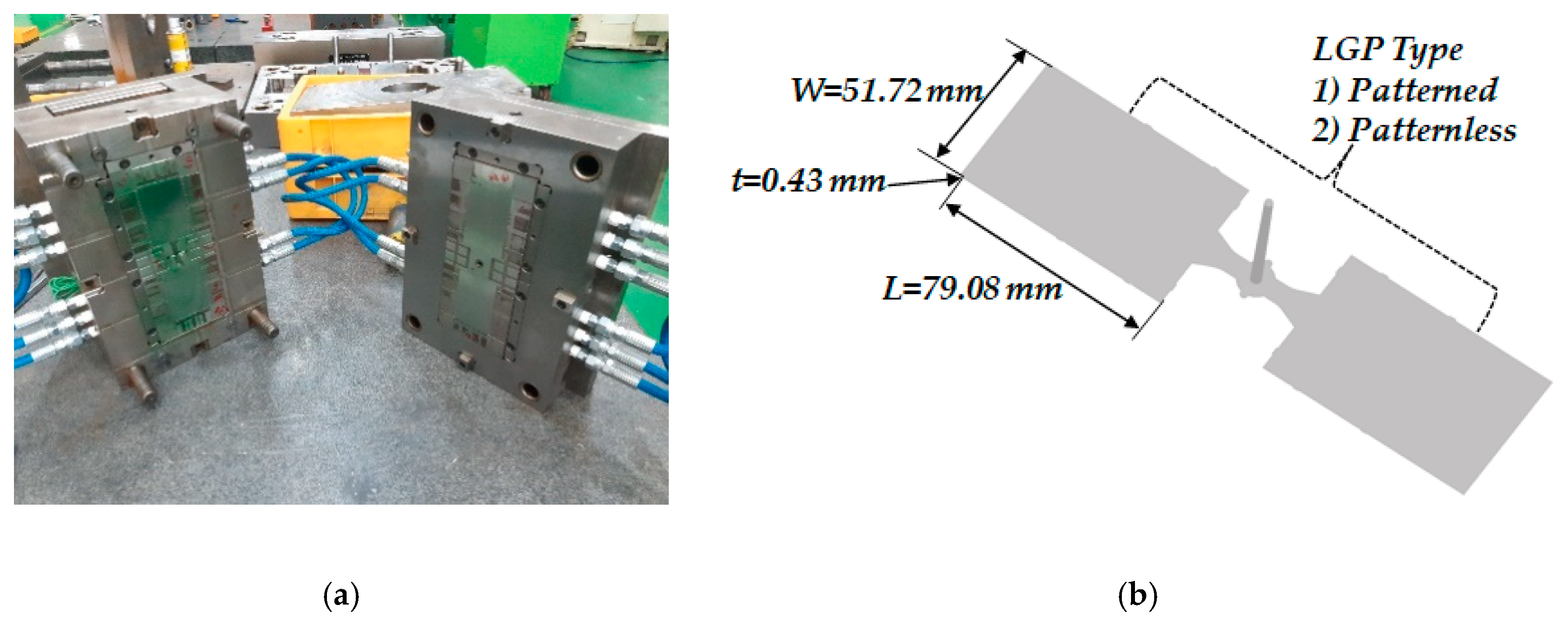

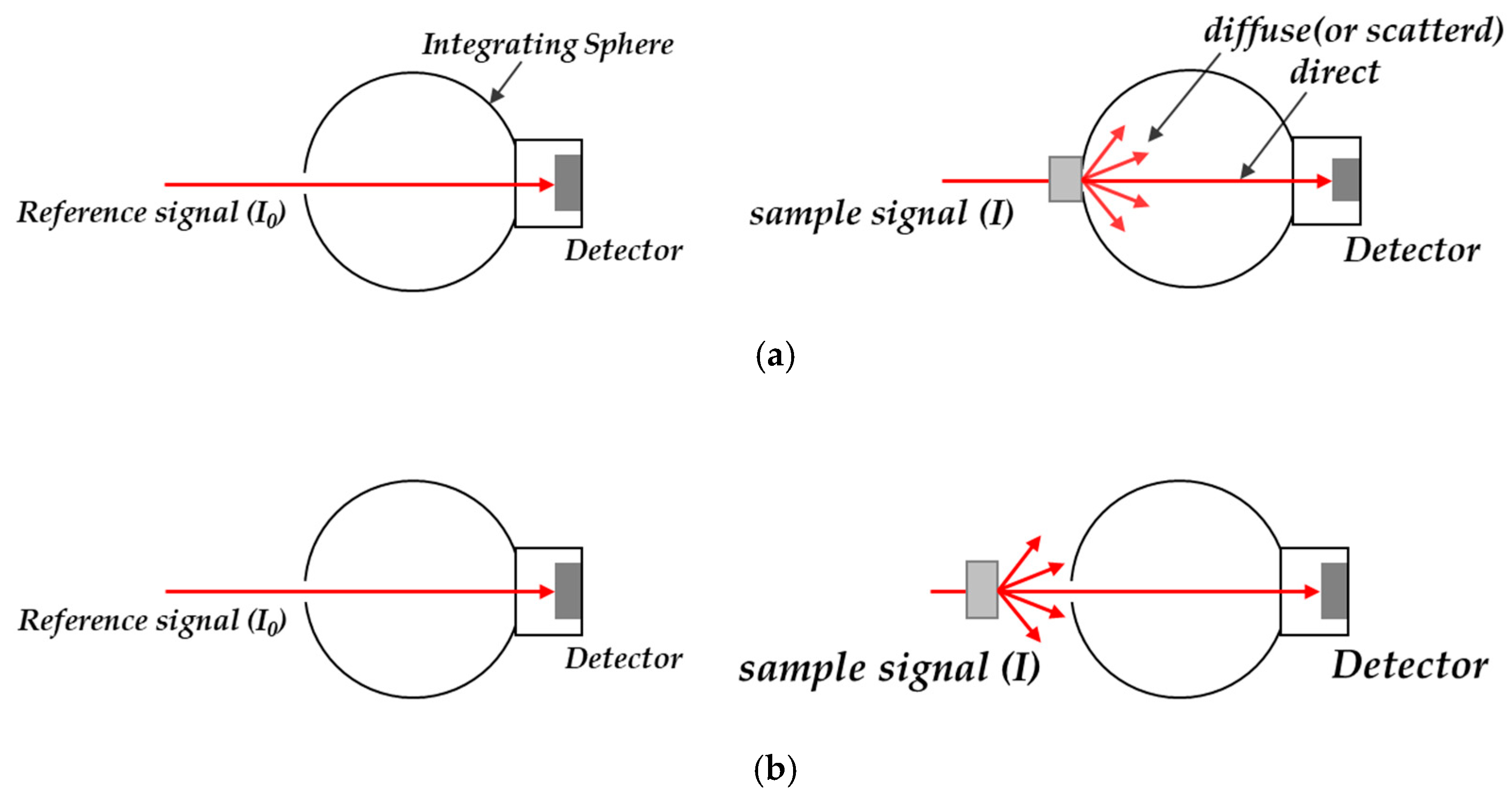

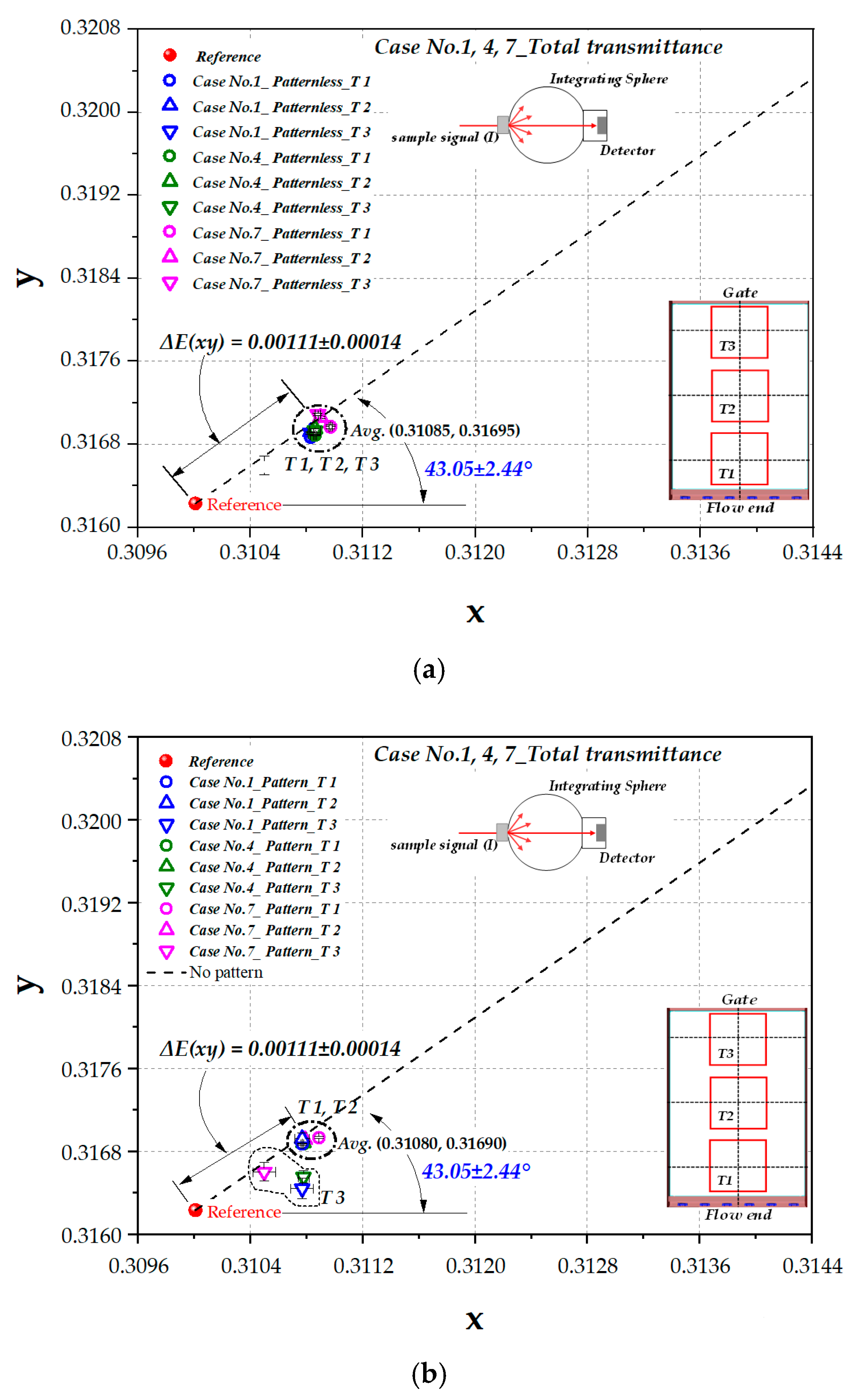

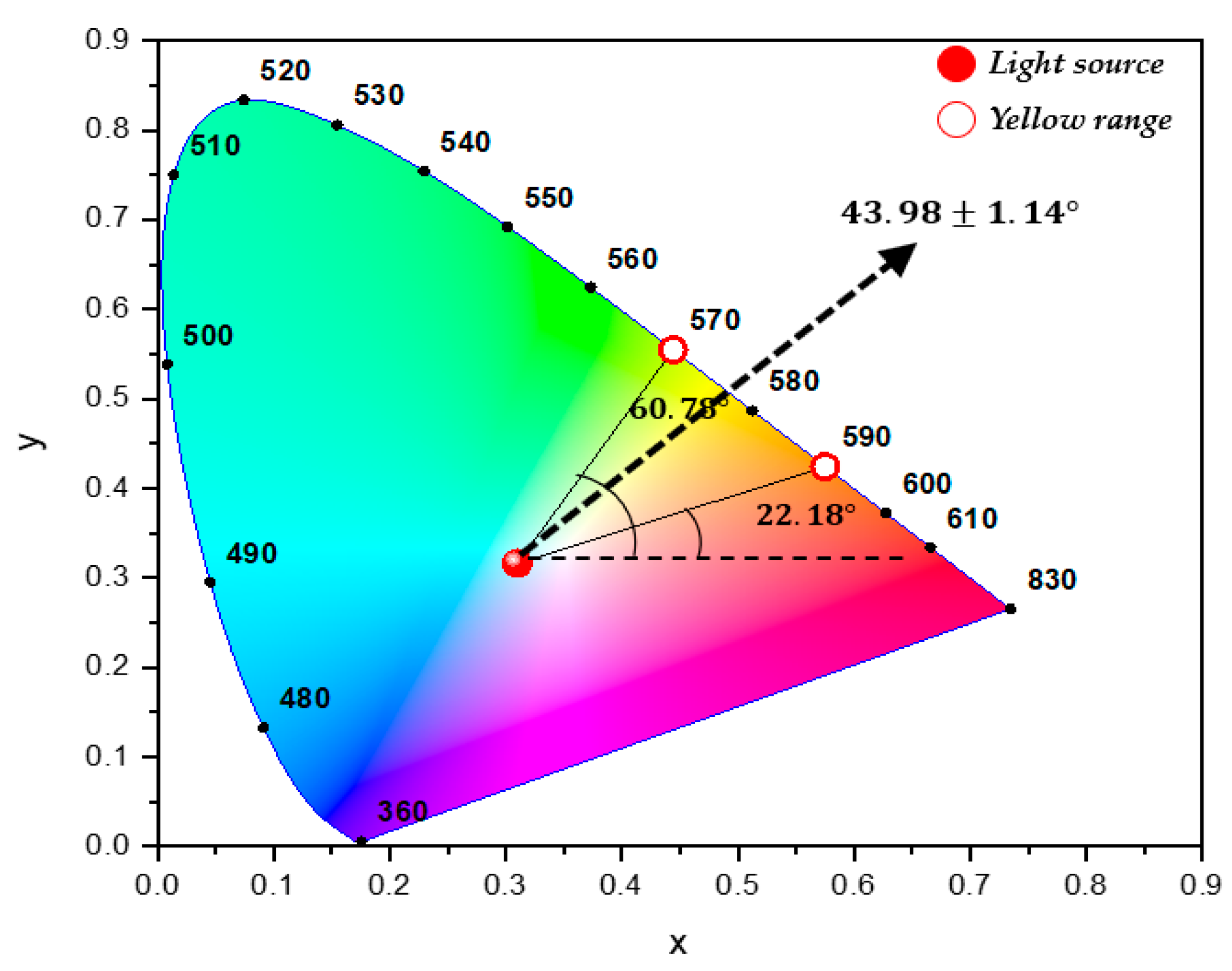
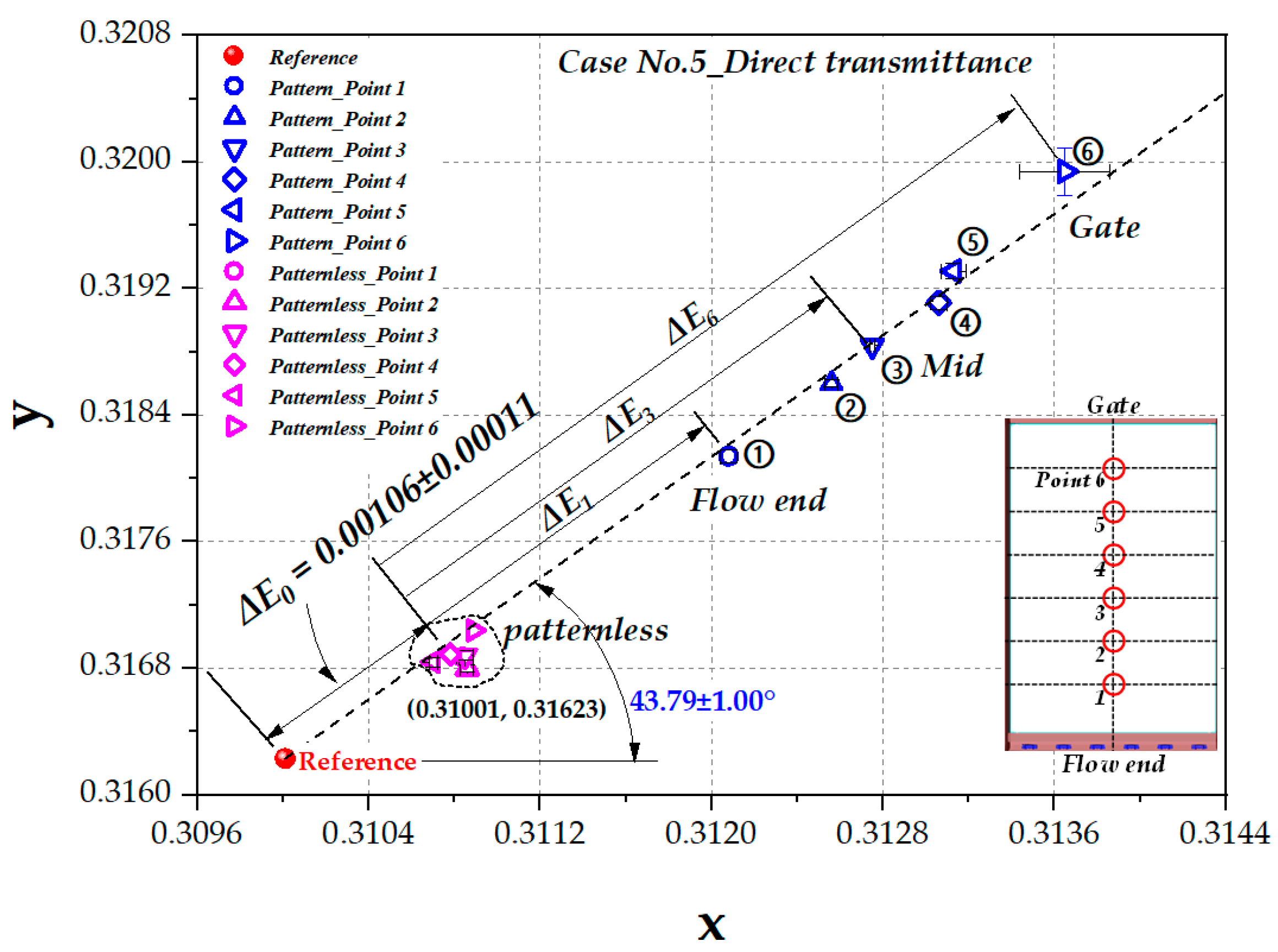
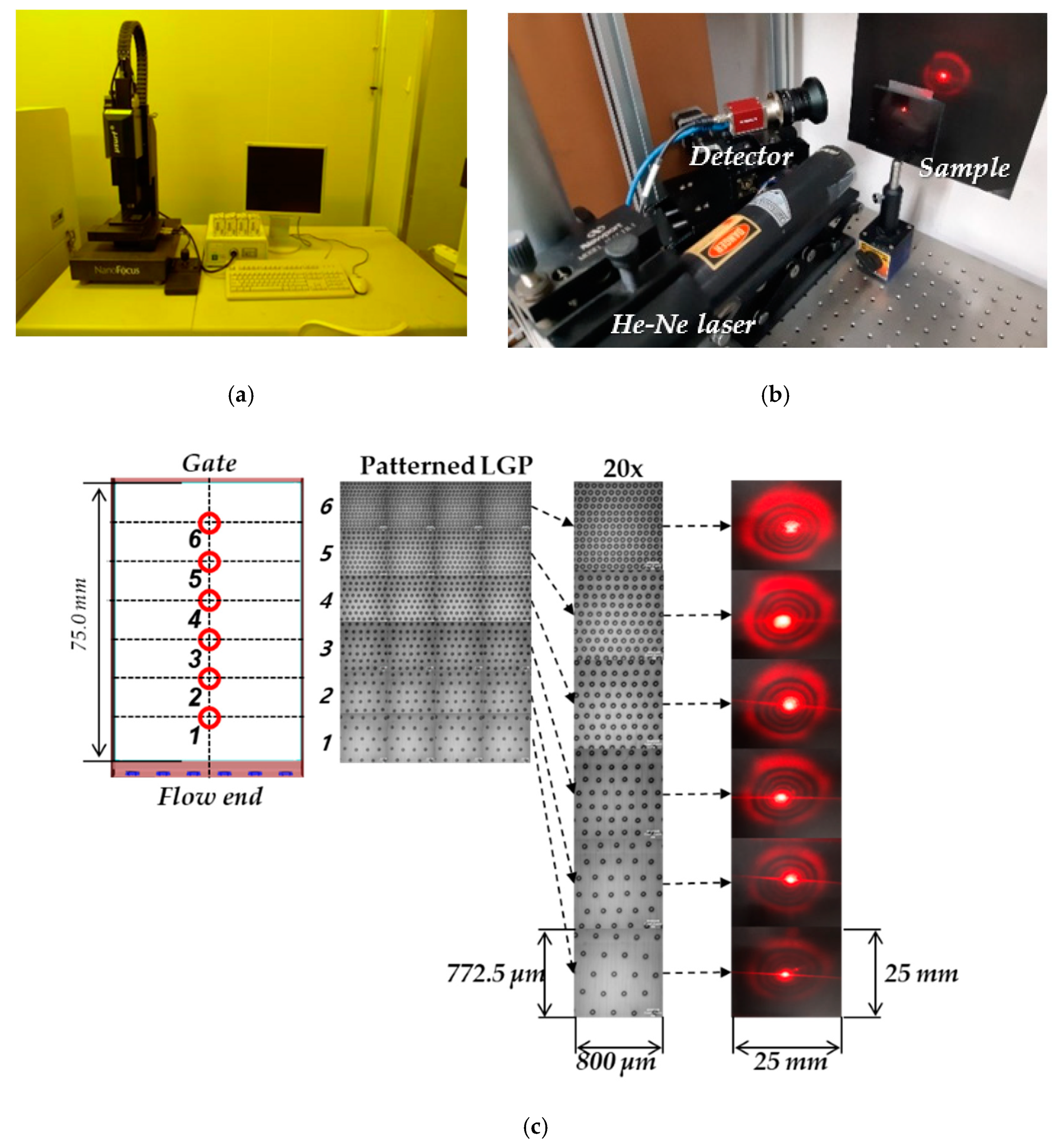

| Properties | ISO Standard | Condition | Unit | Value | |
|---|---|---|---|---|---|
| Physical | Specific gravity | ISO 1183 | 250 | ton | |
| MFR | ISO 1133 | 300 °C, 1.2 kg | g/10 min | 72 | |
| Mechanical | Tensile modulus | ISO527 | MPa | 2300 | |
| Flexural modulus | ISO178 | MPa | 2500 | ||
| Thermal | Heat deflection temp. | ISO75-2/A | 1.8 MPa | °C | 123 |
| Optical | Total light transmittance | JIS-K7361 | % | 90.11 | |
| Refractive index | MEP | 1.59 | |||
| Item | Value | Unit |
|---|---|---|
| Clamping force | 250 | ton |
| Screw diameter | 32 | mm |
| Max. injection speed | 1200 | mm/s |
| Max. injection pressure | 3800 | bar |
| Injection acceleration | 5.02 | G |
| Level 1 | Level 2 | Level 3 | |
|---|---|---|---|
| Melt temperature (°C) | 340 | 360 | 380 |
| Injection speed (mm/s) | 400 | 600 | 800 |
| Mold temperature (°C) | 70 | 80 | 90 |
| Packing pressure (MPa) | 30 | 40 | 50 |
| Case No. | Melt Temp. | Inj. Speed | Mold Temp. | Packing |
|---|---|---|---|---|
| 1 | 1 | 1 | 1 | 1 |
| 2 | 1 | 2 | 2 | 2 |
| 3 | 1 | 3 | 3 | 3 |
| 4 | 2 | 1 | 2 | 3 |
| 5 | 2 | 2 | 3 | 1 |
| 6 | 2 | 3 | 1 | 2 |
| 7 | 3 | 1 | 3 | 2 |
| 8 | 3 | 2 | 1 | 3 |
| 9 | 3 | 3 | 2 | 1 |
| Photometric System | Double Beam |
|---|---|
| Light source | Halogen lamp (visible), deuterium lamp (UV range) |
| Detectors | R928 PMT(UV-Vis) |
| Limiting resolution | <0.048 nm (UV-Vis) |
| Wavelength range | 175–3300 nm |
| Wavelength accuracy | ±0.08 nm at UV-Vis (190–900 nm) |
| Photometric accuracy | <0.00025 Abs (at 0.3 Abs UV-Vis) |
Publisher’s Note: MDPI stays neutral with regard to jurisdictional claims in published maps and institutional affiliations. |
© 2020 by the authors. Licensee MDPI, Basel, Switzerland. This article is an open access article distributed under the terms and conditions of the Creative Commons Attribution (CC BY) license (http://creativecommons.org/licenses/by/4.0/).
Share and Cite
Kim, M.; Lee, J.; Yoon, K. An Experimental Study on Color Shift of Injection-Molded Mobile LGP Depending on Surface Micropattern. Polymers 2020, 12, 2610. https://doi.org/10.3390/polym12112610
Kim M, Lee J, Yoon K. An Experimental Study on Color Shift of Injection-Molded Mobile LGP Depending on Surface Micropattern. Polymers. 2020; 12(11):2610. https://doi.org/10.3390/polym12112610
Chicago/Turabian StyleKim, Mooyeon, Junhan Lee, and Kyunghwan Yoon. 2020. "An Experimental Study on Color Shift of Injection-Molded Mobile LGP Depending on Surface Micropattern" Polymers 12, no. 11: 2610. https://doi.org/10.3390/polym12112610





